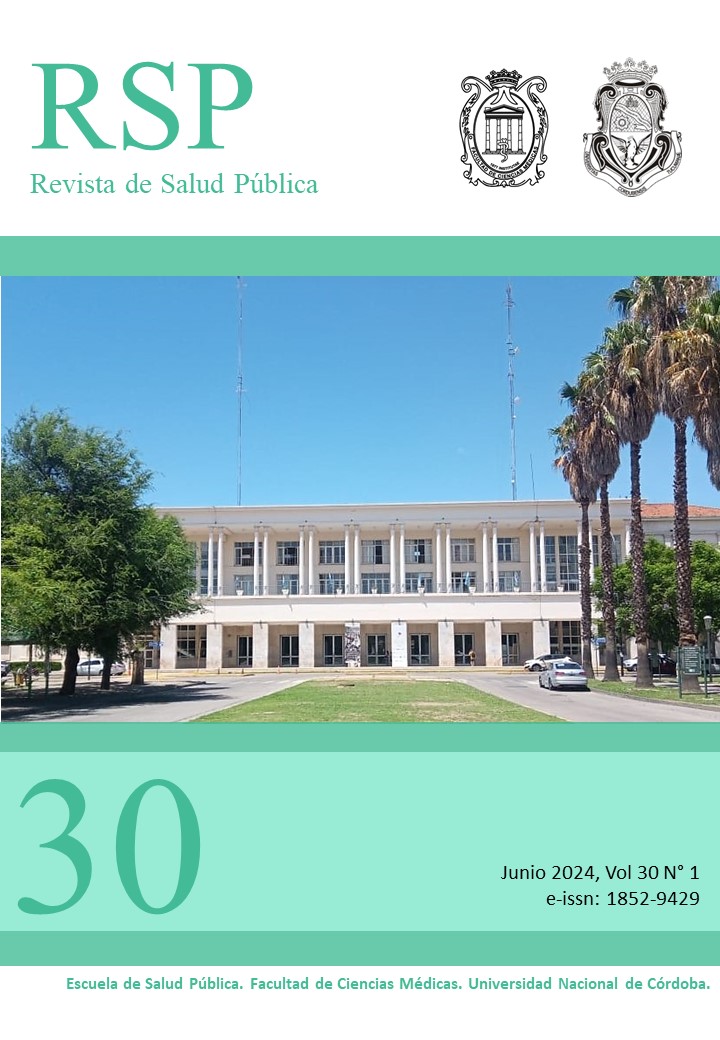Occupational Noise Exposure in a Metalworking Company in Cartagena de Indias, 2023
DOI:
https://doi.org/10.31052/1853.1180.v30.n1.42908Keywords:
Assesment , Working conditions, Measurement, Permissible limit values, Risk levelAbstract
The objective of this study is to assess occupational noise exposure in a metalworking company according to current legal regulations in order to reduce the impact on workers’ health. We carried out research with a descriptive, quantitative, and cross-sectional design. Study population is made up of 8 workers, intentionally selected by the company, who are exposed to noise levels likely to exceed the permissible limit and to significant noise episodes during the workday. A conventional REED brand sound level meter, model R8090, previously calibrated with an "A" weighting filter and slow response (SLOW), was used. The strategy and measurement of sound pressure levels at different workstations were guided by ISO 9612:2010 standards. According to the results of sound pressure level measurements in the metalworking company, workers involved in the disassembly of equipment and electronic parts are exposed to noise levels exceeding the permissible limits of 85 dBA established in Resolution 1792 of 1990 by the Ministry of Labor, which indicates a high probability of permanent hearing loss. We recommend future research regarding the loss of hearing capacity in workers with chronic exposure to high levels of occupational noise in the metalworking sector.
Downloads
References
Castejón Vilella E, Guardino Solá J, Barraza Sanches X. Higiene Industrial. Barcelona: Editorial UOC. 2014.
Mateo Floria P. Gestión de la higiene industrial en la empresa. Madrid: Fundación Confemetal. 2002.
Olege F, Akande T, Olajide T. Occupational noise exposure and sensorineural hearing loss among workers of a steel rolling mill. European Archives of Oto-Rhino-Laryngology and Head & Neck. 2006;263:618-621.
Khilman T, Liden G, Aniansson G. Noise and hearing studies in shipyards. Environ Res. 1976;11(2):182-188.
Mârtiòsone I, rija Baíe M, Martinsone Þ, Eglîte M. Workplace hazards and safety practices in the small-scale industries. Production Engineering Archives. 2024;30(2):241-250.
Beça ASM, Gois J. Occupational noise and hearing loss in a metalworking company. En: Occupational Safety and Hygiene II. 1 Ed. Londres: CRC Press. 2014.
Młyński R, Koslowski E. Noise reduction at the shooting range by means of level-dependent hearing protectors. Med Pr. 2019;70(3):265-273.
Abera Worede E, Worku Yalew, Daba Wami S. Self Reported Hearing Impairments and Associated Risk Factors Among Metal and Woodwork Workers in Gondar Town, North West Ethiopia. Environ Health Insights. 2022;16:11786302221084868.
Smagowska B. An objective and subjective study of noise exposure within the frequency range from 10 kHz to 40 kHz. Archives of Acoustics. 2013; 38(4):559–563.
Nyarubeli I, Tungu A, Bratveit M, Sunde E, Kayumba A, Moen B. Variability and Determinants of Occupational Noise Exposure Among Iron and Steel Factory Workers in Tanzania. Ann Work Expo Health. 2018;62(9):1109-1122.
Hernandez Diaz A, Gonzalez Mendez B. Alteraciones auditivas en trabajadores expuestos al ruido industrial. Med Segur Trab. 2007;53(208):9-19.
Zamorano González B, Parra Sierra V, Vargas Martínez J, Castillo Muraira Y, Vargas Ramos C. Disminución Auditiva de Trabajadores Expuestos a Ruido en una Empresa Metalmecánica. Ciencia & Trabajo. 2010;35:233-236.
Zamorano Gonzalez B, Parra Sierra V, Vargas Matínez JJ, astillo Muraira YVargas Ramos V. Disminución Auditiva de Trabajadores Expuestos a Ruido en una empresa Metalmecánica. 2010;35:233-236.
Ministerio de Protección Social de Colombia. Guía de Atención Integral Basada en la Evidencia para Hipoacusia Neurosensorial Inducida por Ruido en el Lugar de Trabajo (GATI-HNIR). Bogotá. 2006.
ISO 9610. NTP - ISO 9612. Obtenido de NTP - ISO 9612, 2010: Disponible en: https://www.academia.edu/9753456/Determinaci%C3%B3n_de_la_exposici%C3%B3n_a_ruido_laboral_ISO_9612_2010
Giménez de Paz J. Ruido: para los posgrados de higiene y seguridad industrial. de Paz, J. G. Ruido: para los posgrados de higiene y seguridad industrial. Nobuko. 2011.
Instituto Nacional de Seguridad y Salud en el Trabajo -INSST. Guía técnica para la evaluación y prevención de los riesgos relacionados con la exposición al ruido en los lugares de trabajo. Obtenido de Guía técnica para la evaluación y prevención de los riesgos relacionados con la exposición al ruido en los lugares de trabajo. 2022.
Published
How to Cite
Issue
Section
License
Copyright (c) 2024 Escuela de Salud Pública y Ambiente. Facultad de Ciencias Médicas. Universidad Nacional de Córdoba

This work is licensed under a Creative Commons Attribution-NonCommercial 4.0 International License.
Authors who publish with this journal agree to the following terms:
- Authors retain copyright and grant the journal right of first publication with the work simultaneously licensed under a Creative Commons Attribution License which allows the work to be copied, distributed, exhibited and interpreted as long as it is not done for commercial purposes.
- Authors are able to enter into separate, additional contractual arrangements for the non-exclusive distribution of the journal's published version of the work (e.g., post it to an institutional repository or publish it in a book), with an acknowledgement of its initial publication in this journal.
- Authors are permitted and encouraged to post their work online (e.g., in institutional repositories or on their website) after the publication process. (See The Effect of Open Access). (See The Effect of Open Access).



